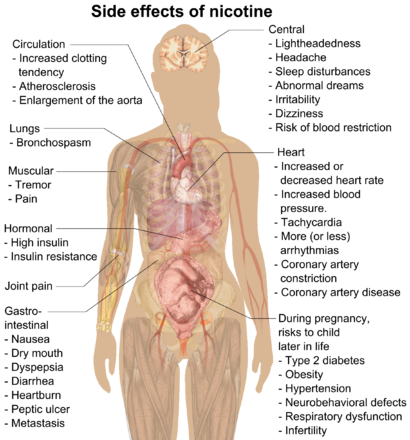Electronic cigarette facts for kids
An electronic cigarette (e-cigarette) or vape is a device that simulates tobacco smoking. It consists of an atomizer, a power source such as a battery, and a container such as a cartridge or tank. Instead of smoke, the user inhales vapor. As such, using an e-cigarette is often called "vaping". The atomizer is a heating element that vaporizes a liquid solution called e-liquid, which quickly cools into an aerosol of tiny droplets, vapor and air. The vapor mainly comprises propylene glycol and/or glycerin, usually with nicotine and flavoring. Its exact composition varies, and depends on several things including user behavior.
E-cigarettes are activated by taking a puff or pressing a button. Some look like traditional cigarettes, and most kinds are reusable.
Nicotine is highly addictive. Users become physically and psychologically dependent. Scientists do not know how harmful e-cigarettes are over the long-term because it is hard to separate the effects of vaping from the effects of smoking when so many people both vape and smoke. E-cigarettes have not been used widely enough or for long enough to be sure.
Vaping is likely far less harmful than smoking, but still harmful. E-cigarette vapor contains fewer toxins than cigarette smoke, at lower concentrations. The vapor contains traces of harmful substances not found in cigarette smoke. E-cigarettes containing nicotine are more effective than nicotine replacement therapy (NRT) for smoking cessation. However, e-cigarettes have not been subject to the same rigorous testing that most nicotine replacement therapy products have, and health warnings may encourage a smoker to quit vaping.
Health effects
E-cigarette use is associated with increased risk of chronic obstructive pulmonary disease, asthma, chronic bronchitis, and emphysema.
Some of the most common but less serious adverse effects include abdominal pain, headache, blurry vision, throat and mouth irritation, vomiting, nausea, and coughing. Nicotine is addictive and harmful to fetuses, children, and young people.
Safety
There is no consensus on the risks of e-cigarette use. There is little data about their safety.
The risk of early death is anticipated to be similar to that of smokeless tobacco. Since vapor does not contain tobacco and does not involve combustion, users may avoid several harmful constituents usually found in tobacco smoke, such as ash, tar, and carbon monoxide. However, e-cigarette use with or without nicotine cannot be considered risk-free because the long-term effects of e-cigarette use are unknown.

The cytotoxicity of e-liquids varies, and contamination with various chemicals have been detected in the liquid. Metal parts of e-cigarettes in contact with the e-liquid can contaminate it with metal particles. Many chemicals including carbonyl compounds such as formaldehyde can inadvertently be produced when the nichrome wire (heating element) that touches the e-liquid is heated and chemically reacted with the liquid.
Another common chemical found in e-cigarettes is ketene. When it enters the lungs after inhaled, this chemical causes damage to the cellular structure of lung tissue causing the cells to not function at maximum capacity and not absorb gasses as readily. This can cause shortness of breath which can lead to other health conditions such as tachycardia and respiratory failure. E-cigarette users who use devices that contain nicotine are exposed to its potentially harmful effects.
Nicotine is associated with cardiovascular disease, possible birth defects, and poisoning.
E-cigarettes create vapor that consists of fine and ultrafine particles of particulate matter, with the majority of particles in the ultrafine range. The vapor have been found to contain propylene glycol, glycerin, nicotine, flavors, small amounts of toxicants, carcinogens, and heavy metals, as well as metal nanoparticles, and other substances. Many carcinogenic compounds have been detected in e-cigarettes, such as N-Nitrosonornicotine (NNN), N-Nitrosoanatabine (NAT), etc., all of which have been proven to be harmful to human health.
E-cigarette vapor potentially contains harmful chemicals not found in tobacco smoke. E-cigarette use by a parent might lead to inadvertent health risks to offspring.
Environmental impact
E-cigarettes that are not reusable contribute to the problem of electronic waste, which can create a hazard for people and other organisms. If improperly disposed of, they can release heavy metals, nicotine, and other chemicals from batteries and unused e-liquid.




